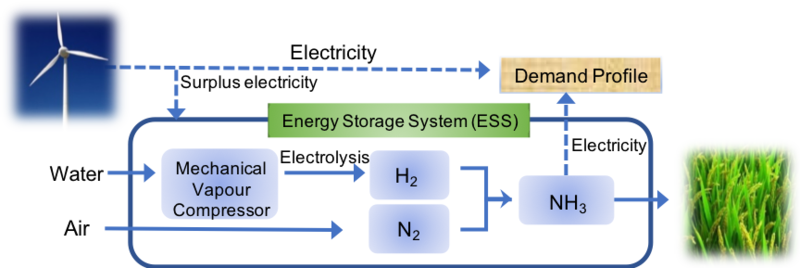Green ammonia demonstration programme: Siemens and Professor Edman Tsang
Chemists from the Tsang group are working with Siemens to develop new catalyst technology for an ambitious Green Ammonia process, wholly powered by renewable energy.
Synthetic ammonia is essential for modern civilisation, supplying roughly half of all the nitrogen found in food crops. Production on this scale, however, consumes over 1% of the world’s energy and accounts for 1.6% of global CO2 emissions. Current technology uses natural gas as the source of both energy and hydrogen to make ammonia in the Haber-Bosch process. The Siemens-Oxford collaboration aims to instead use electricity from wind turbines, one of Siemens’ core businesses, to produce hydrogen from water electrolysis, and then react it with nitrogen in a new decreased temperature and pressure ‘agile’ e-Haber Bosch (e-HB) process. This concept also provides an effective route to capture surplus renewable electricity; when the wind stops blowing the synthesised ammonia can also be burned to regenerate electricity for the grid.

Established in 2015, the Oxford team is led by Prof Edman Tsang, head of the Wolfson Catalysis Centre. The immediate goal for the Oxford team has been to develop and test catalysts for the e-HB process and the first generation of catalysts has recently been patented. There is also a strong focus on future technologies and several novel electrochemical reactors have been designed and are undergoing testing. The world’s first ‘green’ ammonia energy demonatration plant was commissioned in June 2018 at Rutherford Appleton Laboratory, as part of a £1.5M Innovate UK collaboration between Siemens, the University of Oxford, STFC, and Cardiff University. The wind-powered plant demonstrates the complete ammonia energy cycle of renewable power, energy storage as ammonia, and conversion back to electricity.
Professor Edman Tsang's research is on both fundamental and applied aspects of novel chemistry materials and catalysis. His work involves synthesis, testing and characterisation of novel solid state materials for a wide range of applications particularly in the areas of catalysis, sensor and bio-medicine. In the area of catalysis, his group includes work on new catalytic techniques for sustainable energy systems (fuel cell catalysts, photocatalytic solar cells, biomasses to fuel conversion, wind-to-ammonia, hydrogen storage, cleaner catalytic combustion, carbon dioxide activation, capture, storage and conversion into useful chemicals and materials.